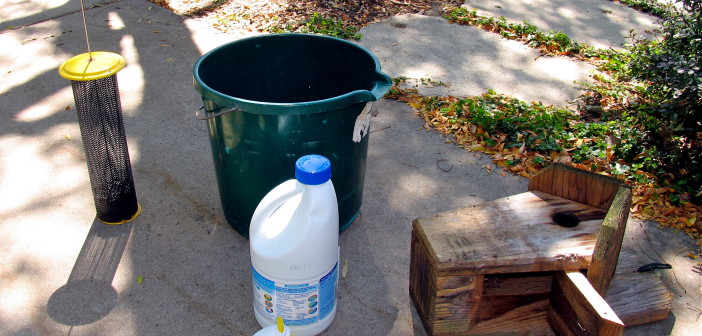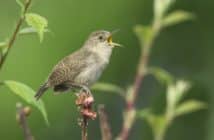Most of us don’t expect to find a mouse inside our bird feeder, as seen in the photo below, but that would be a good reason to clean it. A close look shows this feeder needs cleaning for other reasons, too, including leftovers and debris inside. And birds also appreciate clean housing that isn’t contaminated by germs and parasites. Keeping their food and nesting places safe is essential to their health.
Cleaning bird feeders
We know birds like to keep things clean because adults don’t defecate in their nests, and parents remove their nestlings’ droppings. There’s no reason to think birds don’t also like a clean feeder, but from a strictly hygienic standpoint, a dirty one fosters moldy, unhealthy food and, sometimes, dangerous bacteria and parasites. Dirty bird feeders can make birds sick, sometimes fatally.
To ensure you aren’t putting contaminated food into your feeders, protect stored seed from rodents, which can carry bird diseases, and pollute it with feces and dirt.
A feeder should be cleaned every two to four weeks. More often, if necessary: Is dirt or feces stuck to it? Does any of the seed look moldy? (Between cleanings, shake out old seeds stuck to the bottom when refilling the feeder.) Cleaning is especially important during the periods of heaviest usage: late winter, early summer, late summer, and late fall.
Wear rubber gloves. A bucket, some bleach, and a brush (or power washer, if you have one) are all you need. Never use a pesticide. To kill germs and parasites, use a bleach solution of one part bleach to nine parts water (1:9). Position yourself so you won’t inhale any debris in or on the feeder as you clean it. Scrub it inside and out. Rinse well.
For tubular feeders, use a long, narrow brush sized appropriately for the feeder. Such brushes are available at seed stores and online.
This is a good time to rake up and dispose of all the debris accumulated under your bird feeders.
Cleaning birdhouses
Clean birdhouses at least once a year if you want occupants to return season after season. Not only is it essential for the birds’ health, but they prefer a clean environment: they routinely remove their nestlings’ fecal matter from the nest.
Make sure fledglings have left the birdhouse by quietly approaching from the side and gently tapping it. If you hear no noises, raise the hinged roof or sidewall. (Always purchase or build birdhouses that are easy to open—you’ll be glad you did.)
Avoid cleaning birdhouses inside your house—the nesting material will be unsanitary and may contain parasites. Wear rubber gloves. As you remove and dispose of the nest, position yourself so you won’t inhale any of it. Or use a face mask or towel over your nose and mouth. Don’t save the nest for display.
Use a solution of one part bleach to nine parts water (1:9). Scrub the feeder inside and out. Rinse well. Leave out in the sun to dry. Some bird species produce more than one brood per season. So, you may want to leave the birdhouse hanging up for use again. Otherwise, store it where it will stay clean. Some people store birdhouses in plastic bags.
Do you leave your birdhouses hanging outside for birds to roost in over the winter? If so, cleaning and disinfecting them beforehand is a good idea. Then, temporarily plug ventilation holes with foam weatherstripping (remove it before nesting season). If possible, cover the roof with a dark shingle to further insulate and absorb heat from the sun. Position the shingle to overhang the entrance by a couple of inches to help keep out rain and snow. If the house has a rotating entrance hole, move it to the bottom (warm air will rise inside, keeping birds warmer.)
A house used over the winter should be cleaned and disinfected again for spring’s nesting birds. Remove the ventilation plugs and shingle, and rotate the entrance back to the top.
Build a birdhouse; it’s easy
Buy a birdhouse with these best features in mind
All about birds
Plan in winter for next summer’s projects
How to provide nesting places for wildlife







